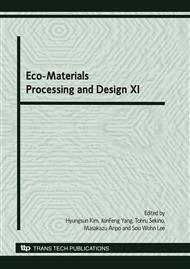p.316
p.320
p.324
p.328
p.332
p.336
p.340
p.344
p.348
Elastic and Plastic Deformation Behaviors of Lotus-Type Porous Copper
Abstract:
The elastic and plastic deformation behaviors of lotus-type porous copper (lotus copper) with cylindrical pores oriented in one direction were investigated using two acoustic methods (resonant ultrasound spectroscopy and acoustic emission method). All the independent components of elastic stiffness were determined by resonant ultrasound spectroscopy combined with electromagnetic acoustic resonance method, which revealed that the Young’s modulus exhibits the anisotropy originating from the anisotropic porous structure and anisotropic matrix texture. The porosity dependence of the anisotropic Young’s modulus can be calculated by the micromechanics modeling based on effective-mean-field theory. The tensile deformation behavior of lotus copper was analyzed by acoustic emission method, which revealed that many burst acoustic emission signals are detected during the tensile deformation. This implies that many cracks are formed during the tensile deformation.
Info:
Periodical:
Pages:
332-335
Citation:
Online since:
July 2010
Authors:
Price:
Сopyright:
© 2010 Trans Tech Publications Ltd. All Rights Reserved
Share:
Citation:


